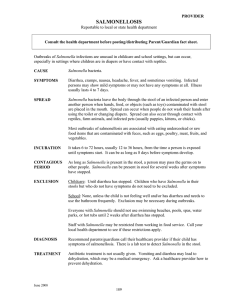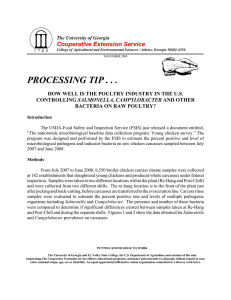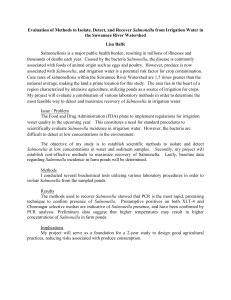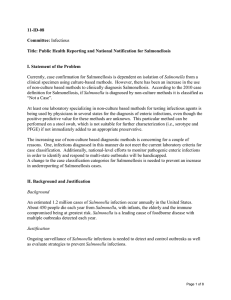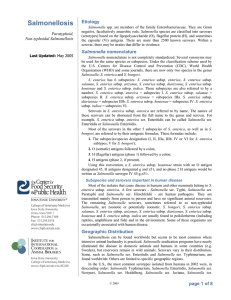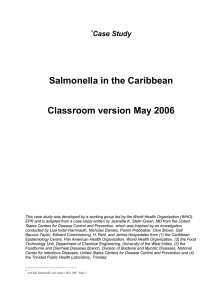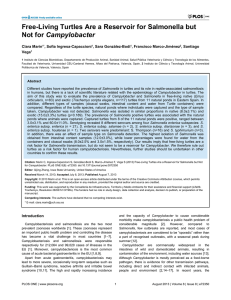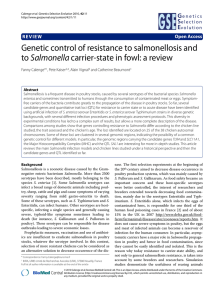Occupational Health - Zoonotic Disease Fact Sheet #8 SALMONELLOSIS
advertisement
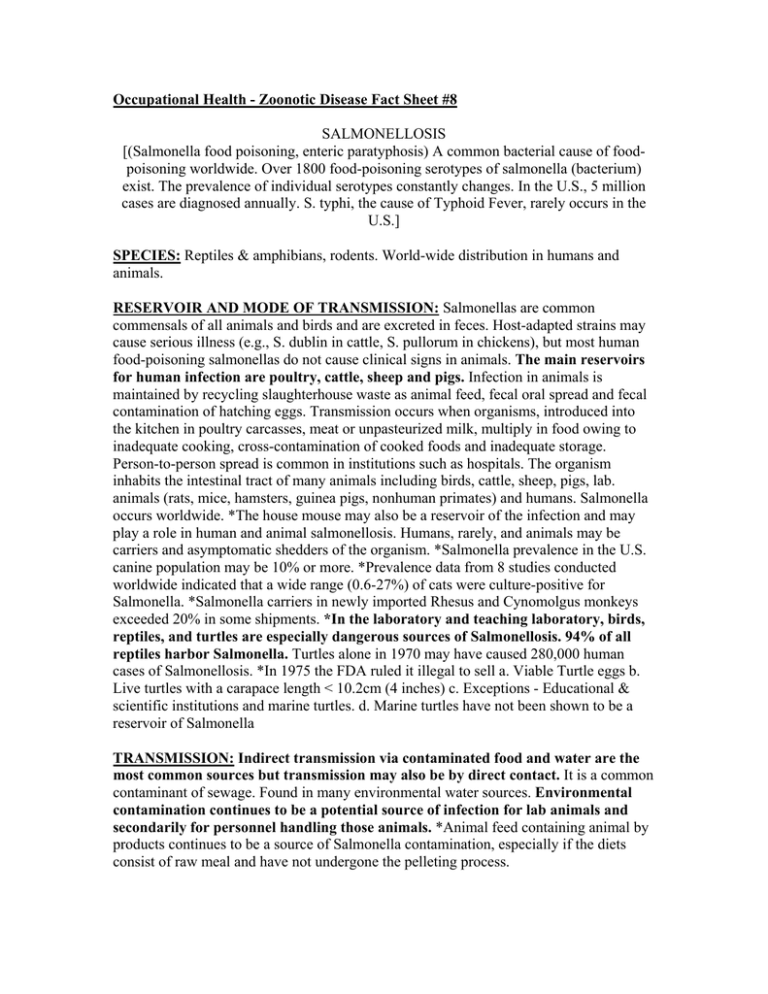
Occupational Health - Zoonotic Disease Fact Sheet #8 SALMONELLOSIS [(Salmonella food poisoning, enteric paratyphosis) A common bacterial cause of foodpoisoning worldwide. Over 1800 food-poisoning serotypes of salmonella (bacterium) exist. The prevalence of individual serotypes constantly changes. In the U.S., 5 million cases are diagnosed annually. S. typhi, the cause of Typhoid Fever, rarely occurs in the U.S.] SPECIES: Reptiles & amphibians, rodents. World-wide distribution in humans and animals. RESERVOIR AND MODE OF TRANSMISSION: Salmonellas are common commensals of all animals and birds and are excreted in feces. Host-adapted strains may cause serious illness (e.g., S. dublin in cattle, S. pullorum in chickens), but most human food-poisoning salmonellas do not cause clinical signs in animals. The main reservoirs for human infection are poultry, cattle, sheep and pigs. Infection in animals is maintained by recycling slaughterhouse waste as animal feed, fecal oral spread and fecal contamination of hatching eggs. Transmission occurs when organisms, introduced into the kitchen in poultry carcasses, meat or unpasteurized milk, multiply in food owing to inadequate cooking, cross-contamination of cooked foods and inadequate storage. Person-to-person spread is common in institutions such as hospitals. The organism inhabits the intestinal tract of many animals including birds, cattle, sheep, pigs, lab. animals (rats, mice, hamsters, guinea pigs, nonhuman primates) and humans. Salmonella occurs worldwide. *The house mouse may also be a reservoir of the infection and may play a role in human and animal salmonellosis. Humans, rarely, and animals may be carriers and asymptomatic shedders of the organism. *Salmonella prevalence in the U.S. canine population may be 10% or more. *Prevalence data from 8 studies conducted worldwide indicated that a wide range (0.6-27%) of cats were culture-positive for Salmonella. *Salmonella carriers in newly imported Rhesus and Cynomolgus monkeys exceeded 20% in some shipments. *In the laboratory and teaching laboratory, birds, reptiles, and turtles are especially dangerous sources of Salmonellosis. 94% of all reptiles harbor Salmonella. Turtles alone in 1970 may have caused 280,000 human cases of Salmonellosis. *In 1975 the FDA ruled it illegal to sell a. Viable Turtle eggs b. Live turtles with a carapace length < 10.2cm (4 inches) c. Exceptions - Educational & scientific institutions and marine turtles. d. Marine turtles have not been shown to be a reservoir of Salmonella TRANSMISSION: Indirect transmission via contaminated food and water are the most common sources but transmission may also be by direct contact. It is a common contaminant of sewage. Found in many environmental water sources. Environmental contamination continues to be a potential source of infection for lab animals and secondarily for personnel handling those animals. *Animal feed containing animal by products continues to be a source of Salmonella contamination, especially if the diets consist of raw meal and have not undergone the pelleting process. CLINICAL FEATURES: Humans.The presence and severity of symptoms depends on the infecting dose. Typically there is watery diarrhoea for about ten days, possibly leading to dehydration, with abdominal pain and low-grade fever. Septicemia and abscess formation are rare. Animals. Subclinical infection is common and many animals may be intermittent or persistent carriers. However, cows may suffer with fever, diarrhoea and abortion. Calves undergo epizootic outbreaks of diarrhoea with high mortality. In pigs, fever and diarrhoea are less common than in cattle. Infected sheep, goats and poultry usually show no signs of infection. DIAGNOSIS: Humans. Isolate salmonella from feces and suspected foods using selective media followed by serotyping and, if appropriate, phage typing. Animals. Culture feces, postmortem tissues and foods of animal origin. Serological tests are of limited value as many noninfected animals have titers from past infections. Humans. Usually only a self-limiting illness occurs. Deaths from dehydration or septicemia are rare and occur usually in infants, or debilitated or elderly patients. Animals. There is abortion in cattle and endometritis with temporary infertility. In calves, dehydration and septicemia may lead to death. PREVENTION: Animals. Principles of control include the following: maintain closed herds and flocks; keep animals in small groups; purchase replacements direct from the farm of origin; avoid mixing animals from different sources; sterilize ingredients of animal feed; provide mains drinking water for grazing livestock; prevent access of wild birds and rodents to animal houses; completely destock animals and thoroughly cleanse and disinfect housing between batches; monitor poultry breeding stock and remove excreters; disinfect hatching eggs and fumigate incubators. Protective clothing, sanitation, and personal hygiene important. TREATMENT: Humans. Treatment of uncomplicated enterocolitis is symptomatic only. Young, malnourished, or immunocompromised infants, severely ill patients, those with sickle cell disease, and those with suspected bacteremia should be treated for 3-5 days with trimethoprim-sulfamethoxazole (one double-strength tablet twice a day), ampicillin (100 mg/kg IV or orally), or ciprofloxacin 9750 mg twice daily). Animals. Treatment with antibiotics and sulfonamides immediately diarrhoea and fever occur reduces mortality but is contraindicated in healthy carriers in which treatment may prolong the carrier state. LEGISLATION: Humans. The disease is notifiable specifically in the USA, Australia, New Zealand and several European countries, or as food-poisoning in the UK. BIOSAFETY LEVEL: BL-2


